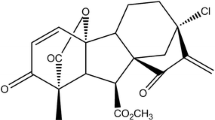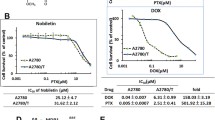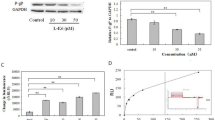Abstract
Failure of current anticancer drugs mandates screening for new compounds of synthetic or biological origin to be used in cancer therapy. Multidrug resistance (MDR) is one of the main obstacles in the chemotherapy of cancer. Efflux of cytotoxic agents mediated by P-glycoprotein (P-gp or MDR1) is believed to be an important mechanism of multidrug resistance. Therefore, we decided to investigate the antiproliferative effects of seven newly synthesized 1,4-dihydropyridine (DHP) derivatives in comparison to verapamil (VP) and doxorubicin (DOX) on human breast cancer T47D cells and its MDR1 overexpressed and moderately resistant cells (RS cells) using MTT cytotoxicity assay. We also examined the effects of these compounds on cytotoxicity of DOX in these two cell types. The cytotoxicity assays using MTT showed that most of the tested new DHP derivatives and VP at 10 μM concentration had varying levels of toxicity on both T47D and RS cells. The toxicity was mostly in the range of 10–25%. However, the cytotoxicity of these DHP derivatives, similar to VP, was significantly less than DOX when comparing IC50 values. Furthermore, these compounds in general had relatively more cytotoxicity on T47D vs RS cells at 10-μM concentration. Among new DHPs, compounds 7a (3,5-dibenzoyl-4-(2-methylthiazol-4-yl)-1,4-dihydro-2,6-dimethylpyridine) and 7d (3,5-diacetyl-4-[2-(2-chlorophenyl)thiazol-4-yl)]-1,4-dihydro-2,6-dimethylpyridine) showed noticeable potentiation of DOX cytotoxicity (reduction of DOX IC50) compared to DOX alone in both cells, particularly in RS cells. This effect was similar to that of VP, a known prototype of MDR1 reversal agent. In other words, compounds 7a and 7d resensitized RS cells to DOX or reversed their resistance. Results indicate that compound 7d exerts highest effect on RS cells. Therefore, these two newly synthesized DHP derivatives, compounds 7a and 7d, are promising as potential new MDR1 reversal agents and should be further studied on other highly resistant cells due to MDR1 overexpression and with further molecular investigation.




Similar content being viewed by others
References
Cairo MS, Siegel S, Anas N, Sender L. Clinical trial of continuous infusion verapamil, bolus vinblastine, and continuous infusion VP-16 in drug-resistant pediatric tumors. Cancer Res 1989;49:1063–6.
Callies S, de Alwis DP, Wright JG, Sandler A, Burgess M, Aarons L. A population pharmacokinetic model for doxorubicin and doxorubicinol in the presence of a novel MDR modulator, zosuquidar trihydrochloride (LY335979). Cancer Chemother Pharmacol 2003;51:107–18.
Clapham DE. Calcium signaling. Cell 1995;80:259–68.
Dunkern TR, Wedemeyer I, Baumgartner M, Fritz G, Kaina B. Resistance of p53 knockout cells to doxorubicin is related to reduced formation of DNA strand breaks rather than impaired apoptotic signaling. DNA Repair 2003;2:49–60.
Early Breast Cancer Trialists’ Collaborative Group. Systemic treatment of early breast cancer by hormonal, cytotoxic, or immune therapy: 133 randomized trials involving 31,000 recurrences and 24,000 deaths among 75,000 women. Lancet 1992;339:71–84.
Gewirtz DA. A critical evaluation of the mechanisms of action proposed for the antitumor effects of the anthracycline antibiotics adriamycin and daunorubicin. Biochem Pharmacol 1999;17:1311–8.
Giaccone G, Linn SC, Pinedo HM. Multidrug resistance in breast cancer: mechanisms, strategies. Eur J Cancer 1995;31A(7):S15–7.
Godfraind T, Miller R, Wibo M. Calcium antagonism and calcium entry blockade. Pharmacol Rev 1986;38:321–416.
Gottesman MM. Mechanisms of cancer drug resistance. Annu Rev Med 2002;53:615–27.
Hauberman K, Benz B, Gekelen V, Schumacher K, Eichelbaum M. Effects of verapamil enantiomers and major metabolites on the cytotoxicity of vincristine and daunomycin in human lymphoma cell lines. Eur J Clin Pharmacol 1991;40(1):53–9.
Hofmann J, Gekeler V, Ise W, Noller A, Miterdorfer J, Hofer S, et al. Mechanism of action of dexniguldipine-HCl (B8509-035), a new potent modulator of multidrug resistance. Biochem Pharm 1994;49:603–9.
Jensen RL, Wurster RD. Calcium channel antagonists inhibit growth of subcutaneous xenograft meningiomas in nude mice. Surg Neurol 2001;55:275–83.
Jensen RL, Origitano TC, Lee YS, Weber M, Wurster RD. In vitro growth inhibition of growth factor-stimulated meningioma cells by calcium channel antagonists. Neurosurgery 1995;36:365–73.
Jensen RL, Petr M, Wurster RD. Calcium channel antagonist effect on in vitro meningioma signal transduction pathways after growth factor stimulation. Neurosurgery 2000;46:692–702.
Kawase M, Shah A, Gaveriya H, Motohashi N, Sakagami H, Varga A, et al. 3,5-Dibenzoyl-1,4-dihydropyridines: synthesis and MDR reversal in tumor cells. Bioorg Med Chem 2002;10:1051–5.
Kiue A, Sano T, Suzuki K, Inada H, Okumura M, Kikuchi J, et al. Activities of newly synthesized dihydropyridines in overcoming of vincristine resistance, calcium antagonism, and inhibition of photoaffinity labeling of P-glycoprotein in rodents. Cancer Res 1990;50(2):310–7.
Larsen AK, Skladanowski A. Cellular resistance to topoisomerase-targeted drugs from drug uptake to cell death. Biochim Biophys Acta 1998;1400:257–74.
Lee YS, Sayeed MM, Wurster RD. Inhibition of cell growth and intracellular Ca2+ mobilization in human brain tumor cells by Ca2+ channel antagonists. Mol Chem Neuropathol 1994;22:81–95.
Lhotak P, Kurfurst A. Preparation of new organic luminophores based on 3,5-Diacetylpyridines. Czech Chem Commun 1992;57:1937–46.
Marche P, Stepien O. Calcium antagonists and vascular smooth muscle cell reactivity. Z Kardiol 2000;89(2):140–4.
Mosmann T. Rapid colorimetric assay for cellular growth and survival: Application to proliferation and cytotoxicity assays. J Immunol Methods 1983;65:55–63.
Motahari Z, Etebary M, Azizi E. Studying the role of P-glycoprotein in resistance to tamoxifen in human breast cancer T47D cells by immunocytochemistry. Int J Pharmacol 2005;1(2):112–7.
Nagae I, Kohno K, Kikuci J, Kuwano M, Akiyama S, Kiue A, et al. Analysis of structural features of dihydropyridine analogs needed to reverse multidrug resistance and to inhibit photolabeling of P-glycoprotein. Biochem Pharmacol 1989;38:519–27.
Pastan I, Gottesman MM. Multiple-drug resistance in human cancer. N Engl J Med 1987;316:1388–93.
Pommerenke EW, Mattern J, Traugott U, Volm M. Reversal of multidrug resistance with (R)-verapamil in vitro and in vivo. Arzneimittel-Forschung 1991;41(8):855–8.
Putney JW, Bird GS. The inositol phosphate-calcium signaling system in nonexcitable cells. Endocr Rev 1993;14:610–31.
Putney JW, Broad LM, Braun FJ, Lievremont JP, Bird GS. Mechanisms of capacitative calcium entry. J Cell Sci 2001;114:2223–29.
Riordan JR, Ling V. Genetic and biochemical characterization of multidrug resistance. Pharmacol Ther 1985;28:51–75.
Rybalchenko V, Prevarskaya N, Van Coppenolle F, Legrand G, Lemonnier L, Le Bourhis X, et al. Verapamil inhibits proliferation of LNCaP human prostate cancer cells influencing K+ channel gating. Mol Pharmacol 2001;59:1376–87.
Saponara S, Kawase M, Shah A, Motohashi N, Molnar J. 3,5-Dibenzoyl-4-(3-phenoxyphenyl)-1,4-dihydro-2,6-dimethylpyridine (DP7) as a new multidrug resistance reverting agent devoid of effects on vascular smooth muscle contractility. Br J Pharmacol 2004;141:415–22.
Sato W, Fukazawa N, Suzuki T, Yusa K, Tsuruo T. Circumvention of multidrug resistance by a newly synthesized quinoline derivative, MS-073. Cancer Res 1991;51:2420–24.
Schachter M. Vascular smooth muscle cell migration, atherosclerosis, and calcium channel blockers. Int J Cardiol 1997;62(2):S85–90.
Shah A, Gaveriya H, Motohashi N, Kawase M, Saito S, Sakagami H, Satoh K, Tada Y, Solymosi A, Walfard K, Molnar J. 3,5-Diacetyl-1,4-dihydropyridines: synthesis and MDR reversal in tumor cells. Anticancer Res 2000;20:373–8.
Shinoda H, Inaba M, Tsuruo T. In vivo circumvention of vincristine resistance in mice with P388 leukemia using a novel compound, AHC-52. Cancer Res 1989;49:1772–6.
Shinoda H, Ebisu H, Mitsuhashi J, Inaba M, Tsuruo T. Therapeutic efficacy of combination of antitumor agent with AHC-52 against multidrug-resistant cells in the intravenously inoculated P388 leukemia model. Cancer Chemother Pharmacol 1992;30:335–40.
Skovsgaard T. Mechanism of cross-resistance between vincristine and daunorubicin in Ehrlich ascites tumor cells. Cancer Res 1978;38:4722–7.
Son YS, Suh JM, Ahn SH, Kim JC, Yi JY, Hur KC, et al. Reduced activity of topoisomerase II in an Adriamycin-resistant human stomach – adenocarcinoma cell line. Cancer Chemother Pharmacol 1998;41:353–60.
Stepien O, Marche P. Amlodipine inhibits thapsigargin-sensitive Ca2+ stores in thrombin-stimulated vascular smooth muscle cells. Am J Physiol Heart Circ Physiol 2000;279:H1220–7.
Stepien O, Gogusev J, Zhu DL, Iouzalen L, Herembert T, Drueke TB, et al. Amlodipine inhibition of serum-, thrombin-, or fibroblast growth factor-induced vascular smooth-muscle cell proliferation. J Cardiovasc Pharmacol 1998;31:786–93.
Stepien O, Zhang Y, Zhu D, Marche P. Dual mechanism of action of amlodipine in human vascular smooth muscle cells. J Hypertens 2002;20:95–102.
Tasaka S, Ohmori H, Gomi N. Synthesis and structure-activity analysis of novel dihydropyridine derivatives to overcome multidrug resistance. Bioorg Med Chem Lett 2001;11:275–77.
Taylor JM, Simpson RU. Inhibition of cancer cell growth by calcium channel antagonists in the athymic mouse. Cancer Res 1992;52:2413–18.
Tsien RW, Tsien RY. Calcium channels, stores and oscillations. Annu Rev Cell Biol 1990;6:715–60.
Tsuruo T, Iida H, Tsukagoshi S, Sakuri Y. Overcoming of vincristine resistance in P388 leukemia in vivo and in vitro through enhanced cytotoxicity of vincristine and vinblastine by verapamil. Cancer Res 1981;41(5):1967–72.
Tsuruo T, Iida H, Tsukagoshi S, Sakurai Y. Potentiation of vincristine and adriamycin effects in human hemopoietic tumor cell lines by calcium antagonists and calmodulin inhibitors. Cancer Res 1983;43:2267–72.
Twentyman PR. Cyclosporins as drug resistance modifiers. Biochem Pharmacol 1992;43(1):109–17.
Waters D, Lesperance J. Calcium channel blockers and coronary atherosclerosis: from the rabbit to the real world. Am Heart J 1994;128:1309–16.
Yoshida J, Ishibashi T, Nishio M. Antiproliferative effect of Ca2+ channel blockers on human epidermoid carcinoma A431 cells. Eur J Pharmacol 2003;472:23–31.
Zernig G. Widening potential for Ca2+ antagonists: non-L-type Ca2+ channel interaction. Trends Pharmacol Sci 1990;11:38–44.
Acknowledgments
This research was supported by grants from Iran National Sciences Foundation (INSF). Authors would also like to thank the research council of Medical Sciences/University of Tehran for facilitating this research project. We are also thankful to Dr. M.R. Khoshayand for his scientific advice on statistical analysis.
Author information
Authors and Affiliations
Corresponding author
Rights and permissions
About this article
Cite this article
Bazargan, L., Fouladdel, S., Shafiee, A. et al. Evaluation of anticancer effects of newly synthesized dihydropyridine derivatives in comparison to verapamil and doxorubicin on T47D parental and resistant cell lines in vitro. Cell Biol Toxicol 24, 165–174 (2008). https://doi.org/10.1007/s10565-007-9026-x
Received:
Accepted:
Published:
Issue Date:
DOI: https://doi.org/10.1007/s10565-007-9026-x




